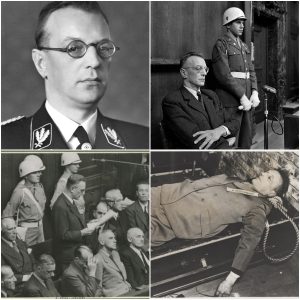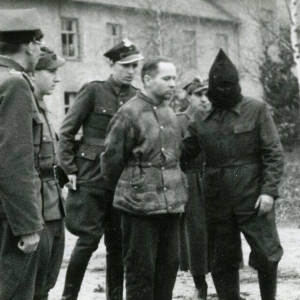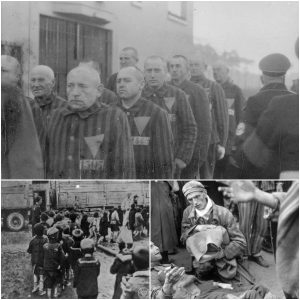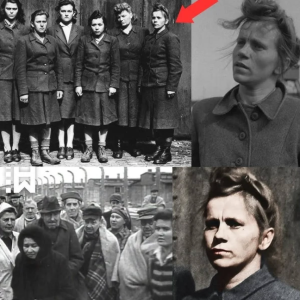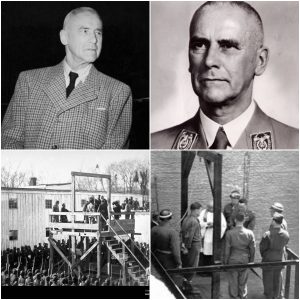In the shadowed annals of the Holocaust, few figures embody the cold machinery of genocide quite like Hans Aumeier. As the deputy commandant of Auschwitz I, this SS-Hauptsturmführer was not just a bureaucrat in Hitler’s death factories—he was a hands-on architect of terror. Under his watch, the main camp became a labyrinth of forced labor, systematic beatings, and mass executions, where human lives were reduced to ash in crematoria he personally oversaw. Aumeier’s legacy is etched in the screams of the condemned: on a single spring day in 1942, he ordered the shooting of 144 women against the bloodstained wall of Block 11, their bodies left as a grim testament to his unyielding cruelty. This is the story of a man who turned obedience into atrocity, and whose end came not in glory, but at the end of a noose.
From Obscure Artisan to SS Enforcer
Hans Aumeier was born on August 20, 1906, in the Bavarian town of Amberg, a place far removed from the ideological storms brewing in post-World War I Germany. The son of a skilled turner and fitter in a rifle factory, young Hans followed a predictable path: four years of elementary school, three in secondary, and then an apprenticeship in the same trade. By 1918, at just 12 years old, he had dropped out without qualifications, drifting through factories in Munich, Berlin, Bremen, and Cologne. Unemployment gnawed at him during the Weimar Republic’s economic woes, molding a restless soul ripe for radicalism.
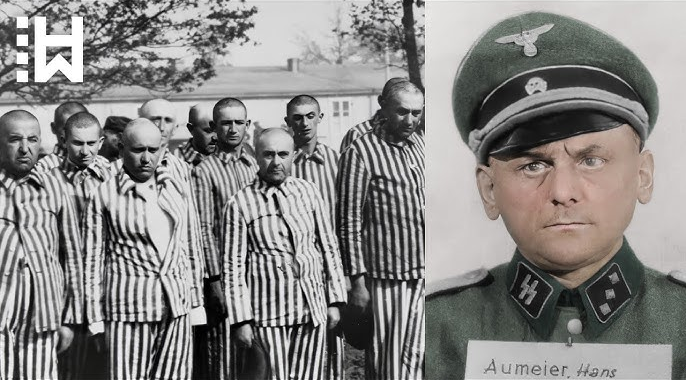
Aumeier’s entry into the Nazi orbit was unremarkable but fateful. In December 1929, he joined the National Socialist German Workers’ Party (NSDAP), drawn by promises of stability and purpose. Two years later, in 1931, he enlisted in the Sturmabteilung (SA), the party’s paramilitary wing, before swiftly transferring to the elite Schutzstaffel (SS) that same December. Assigned as a driver at SS headquarters under the watchful eye of Heinrich Himmler, Aumeier climbed the ranks through loyalty and connections. By the late 1930s, he had honed his skills in the repressive machinery of the Third Reich, serving in various administrative roles that foreshadowed the horrors to come. Little did the world know that this former factory hand would soon oversee the extermination of thousands.
Descent into Auschwitz: Architect of the Main Camp’s Nightmares
Aumeier’s true baptism in blood began on February 1, 1942, when he arrived at Auschwitz I as the new Schutzhaftlagerführer—the protective custody camp leader—and head of Department III. He replaced Karl Fritzsch, inheriting a sprawling complex of barbed wire and barracks that had already claimed countless lives. As deputy to commandant Rudolf Höss, Aumeier wielded near-absolute power over the daily operations of the main camp, enforcing a regime of draconian discipline that blurred the line between labor and liquidation.
His responsibilities were as vast as they were vile. Aumeier supervised the forced labor details that worked prisoners to exhaustion in munitions factories and construction sites, where malnutrition and beatings claimed more victims than the quotas they filled. He empowered criminal kapos—trusted prisoner overseers with a penchant for sadism—granting them unchecked authority that amplified the camp’s terror. Whips cracked, fists flew, and the air reeked of fear under his gaze. But it was Aumeier’s oversight of the crematoria that truly immortalized him as the “Deputy of Death.” He ensured the efficient disposal of bodies from gassings, shootings, and starvation, turning the ovens into a relentless conveyor of industrialized murder. Witnesses later described him striding through the smoke-filled yards, barking orders as flames devoured the evidence of his crimes.
Aumeier’s brutality was not abstract; it was personal and profane. He delighted in the spectacle of punishment, personally administering beatings with a riding crop or his fists to any prisoner who faltered. Testimonies from survivors paint him as a man of explosive temper, quick to order floggings for the pettiest infractions. In one chilling escalation, he participated in the mass reprisals following prisoner escapes, where entire blocks were decimated to instill collective dread.
A Day of Slaughter: The Execution of 144 Women
No single act encapsulates Aumeier’s savagery like the massacre of March 19, 1942. In the courtyard between Blocks 10 and 11—the infamous “death block” of Auschwitz I—144 Jewish women, selected from incoming transports, were lined up against the execution wall. Aumeier, ever the meticulous officer, issued the order himself. SS guards raised their rifles, and in a hail of gunfire, the women crumpled to the ground, their pleas silenced forever. The bodies were left to rot as a warning, only later carted to the crematoria under Aumeier’s supervision.
This was no isolated horror. Just over two months later, on May 27, 1942, Aumeier stood by as 168 more prisoners—men and women alike—met the same fate at the same wall. And on June 10, 1942, in retaliation for an attempted mass escape by the camp’s penal company, he oversaw the shooting of dozens of survivors, their blood mingling with the spring mud. These executions were not mere punishments; they were theater, designed to break the spirit of the living while feeding Aumeier’s unquenchable thirst for control.
Yet, even in this inferno, Aumeier’s downfall loomed. By August 1943, rumors of his corruption reached Berlin. Accused of embezzling gold teeth and valuables stripped from gassing victims, he was transferred out of Auschwitz in disgrace—demoted from a monster to a mere thief in the eyes of his superiors. It was a rare glimpse of irony in an otherwise seamless descent into evil.
Exile and the Illusion of Redemption
Aumeier’s ousting from Auschwitz did not end his complicity. Promoted to SS-Sturmbannführer, he was dispatched to Estonia as commandant of Vaivara concentration camp, where he continued selections for the gas chambers and oversaw the deaths of thousands through starvation and forced marches. By August 1944, as the Red Army advanced, he evacuated the camp, herding survivors toward their doom. Briefly attached to a police battalion near Riga, he participated in Einsatzgruppen-style killings before his final posting: the short-lived Mysen concentration camp in Norway, opened on May 7, 1945—just days before Germany’s surrender.
In a bizarre twist, Aumeier showed fleeting humanity at Mysen. He negotiated with the Norwegian Red Cross for supplies and released prisoners upon liberation the next day. Some historians speculate it was self-preservation, a bid to whitewash his record as the Allies closed in. But redemption was an illusion; the ghosts of Auschwitz trailed him like smoke from the crematoria.
Justice at the Gallows: The Kraków Trial
Allied victory brought swift retribution. On June 11, 1945, British forces arrested Aumeier at Terningmoen camp in Norway, using Gestapo files to unmask him. Interrogated by MI6 and U.S. intelligence, he initially denied knowledge of the gas chambers, claiming ignorance of the Birkenau extermination operations just miles from his post. But under pressure—and later, in detailed statements unearthed in 1992—he confessed to overseeing gassings in Bunkers 1 and 2, describing the Zyklon B process with chilling precision.
Extradited to Poland in 1946, Aumeier faced the Supreme National Tribunal in Kraków during the First Auschwitz Trial, from November 25 to December 16, 1947. Tried alongside 39 other SS men, he stood defiant, insisting he had killed no one personally. Survivor testimonies shattered his facade: accounts of beatings, executions, and the ceaseless roar of the crematoria ovens painted him as a willing cog in the Nazi killing machine. On December 22, 1947, the court sentenced him to death for crimes against humanity.
On January 24, 1948, in the grim confines of Montelupich Prison, Hans Aumeier, the Deputy of Death, met his end. At 41 years old, he was led to the gallows and hanged, his neck snapping in the cold Polish winter. As the trapdoor fell, the echoes of 144 women’s final breaths—and countless more—finally found a measure of silence.
A Legacy of Ash
Hans Aumeier’s story is a stark reminder of how ordinary men become monsters under the banner of ideology. From the factories of Bavaria to the firing squads of Auschwitz, his life was a trajectory of escalating depravity, halted only by the scales of justice. Today, as we reflect on the Holocaust’s 6 million murdered souls, Aumeier’s name serves as a warning: evil thrives not in the extraordinary, but in the compliant. The crematoria he supervised may have cooled, but the flames of memory burn eternal, ensuring that deputies of death like him are never forgotten.

